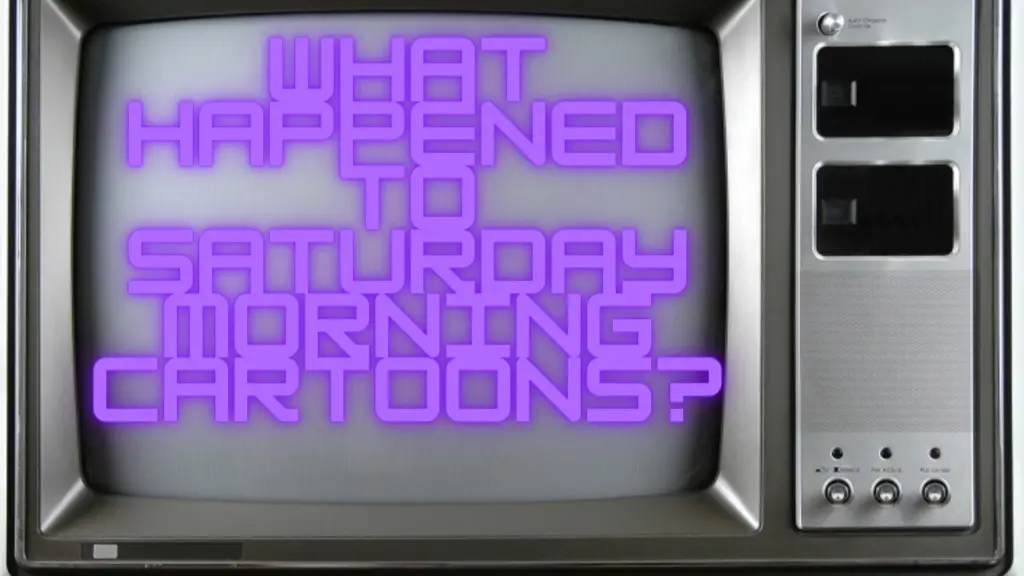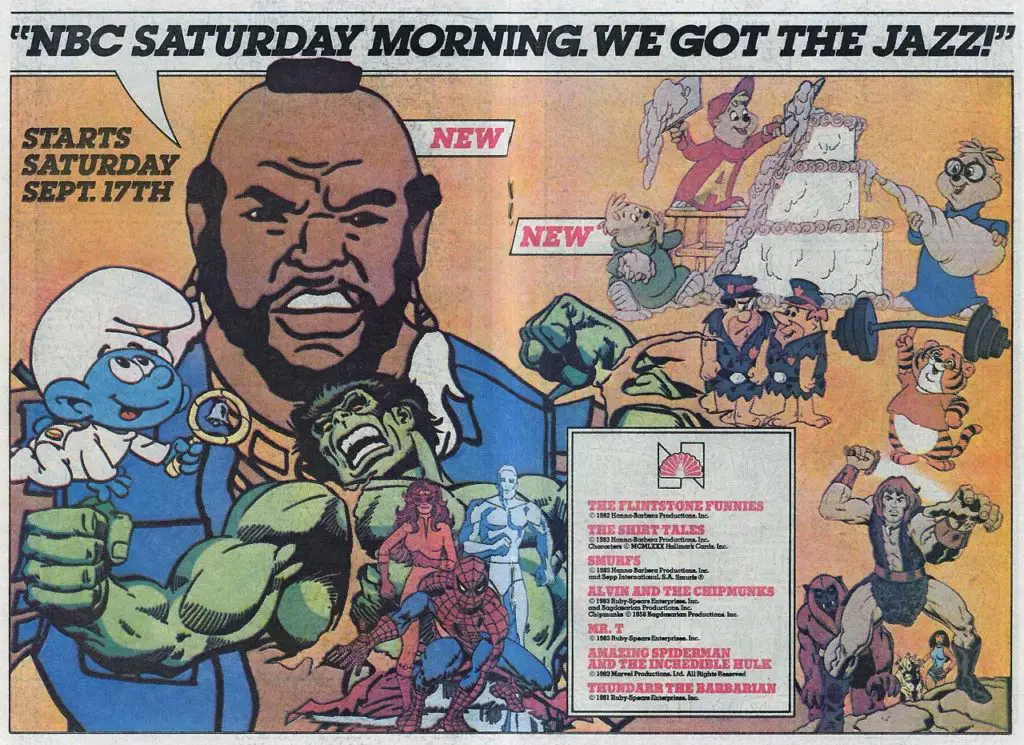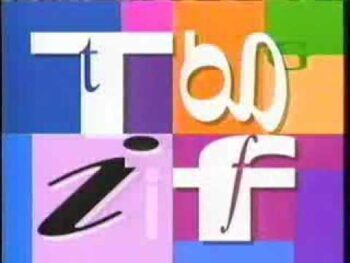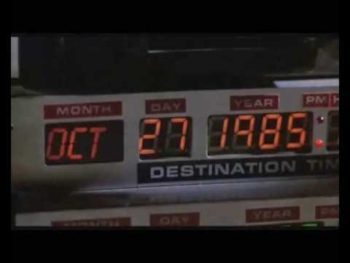
It was like a mini Christmas each week. The thrill of each week’s Saturday morning cartoons was what you waited for throughout the entire week. But what happened to them?
Saturday Morning cartoons started in the late 60s and rose to prominence during the 1980s. Their low cost made them a perfect platform to market to children. Despite their prominence, regulations would eventually lead to their demise in favor of live-action programming.
I don’t know what it was about Saturday morning cartoons, but on Friday nights, I could barely sleep. I’m not sure if it was the anticipation, the excitement, or that everything was new. The key thing is that they were a staple in the lives of kids of the 80s.
These cartoons have their roots in commerce, but as restrictions about what could be targeted to kids tightened, it became too difficult for networks to keep them up and they disappeared.
My Love of Saturday Morning Cartoons
Getting up for school each day was such a struggle. But on Saturday mornings, I was up before the sun. I remember lying in bed—while it was still dark out—and not being able to contain myself for what was to come.
My parents wouldn’t let me go downstairs until at least 7:00 am. But most Saturday mornings, I was up before 6. I would have to wait for an excruciation hour before being allowed down. Eventually, I was able to finagle my way downstairs earlier and earlier.
And I’m glad I did. Where I lived in Canada, our networks would show old black and white shows before cartoons started around 7. At 6 am was the Little Rascals, but more importantly to me was what came on at 6:30am: The Lone Ranger.
This was the black and white version from the 1950s, but it seemed like a brand new show to me. This was as big a highlight as the cartoons themselves. It set the stage for the excitement of the morning.
Once 7 am rolled around, some older cartoons would make their appearance. By 8am—they were in full swing, and the excitement would last until 11 am or whenever my mom made me go outside because my eyes were melting.
My breakfast of choice was toast with honey, and a steady supply was provided. This may have been similar to your experience. But spending on your age, you may remember Saturday morning cartoons earlier or later than the 1980s.
Let’s look at how Saturday mornings became prime time for kids, and how this whole thing grew into a beloved institution.
The Origins of TV and Marketing
When we look at television, we need to acknowledge that television and advertising are one in the same. You could say that the point of all tv shows is to just sell commercials.
When television first launched, no one was sure how to advertise on it. Many companies saw TV as a fad and didn’t think it was worth advertising on it. Advertising up to that point had been on the radio and products and companies would sponsor radio shows, which would give us the name soap opera as many soap and cleaning companies would sponsor radio dramas.
When advertisers learned that TV wasn’t going away, they had to learn how to use it to market their products. THe very first TV commercial was for Bulova watches. But there weren’t any flashy sales tactics, voice overs, or anything to make you feel like you can’t live if you don’t have this watch.
All they did was show the watch for around 16 seconds.
As advertising grew, it became more of an art. Marketers and Mad Men realized that selling the feeling behind a product was more important than the product itself. It was about creating a desire and to make people feel they needed this specific product more than life itself.
This would be important going into the 1980s. But first, we had to get cartoons on TV.
The Early Days of Television Cartoons
TV was exploding into the 1960s. But one primary advancement was required to usher in an era of television cartoons: color TV.
Before color TV, if you wanted to see a cartoon, you had to go to a movie theatre. This would change as now they beamed color cartoons into your own home.
The first color cartoon to debut on TV was the Flintstones in 1960. But they would show the Flintstones in prime time. They did not exactly direct it at kids, and the premise borrowed from the Honeymooners which was meant to draw in an older crowd.
The Flintstones ran for 6 years but was incredibly popular. Other cartoons would follow including:
- Woody Woodpecker
- The Jetson
- Alvin and the Chipmunks
- Mighty Mouse
There wasn’t a concept of Saturday morning cartoons, or even after-school cartoons, so it only made sense to release a new show—even if it was a cartoon—during prime time.
This made them a bit inaccessible to younger kids who couldn’t say up that late. The networks knew that they needed to get these shows in front of kids, but how?
It turns out there was one time slot that was sitting wide open: Saturday mornings.
Creating Saturday Morning Cartoons
The networks had looked at a few different time slots, but Saturday mornings looked best. After school wasn’t a bad idea, but there are the different time zones around the country to consider. Also, kids get out of school at different times, so you couldn’t perfectly coordinate the schedule
Speaking of this, I have a story all about schools getting out at different times and my experience with the GoBots cartoons if you want to check that out here.
So there were a lot of time slots up in the air. But you knew where every kid would be from 8 to 11 am on Saturday mornings: sat in front of the TV.
This was smart to get a bigger audience, but it inadvertently became a marketer’s dream and would change society, laws, and how we protect our kids.
In the late 60s, cartoons were being shown on Saturday mornings. It didn’t take long for this to become an established thing. But they were not yet at the level we would come to know. There also wasn’t a lot of great content. It’s important to remember that this time slot was just to show cartoons that had previously aired during prime time. The cartoons of Saturday mornings were just reruns.
Several production companies decided to shake things up by creating original programming. This would be a way for them to stand out amongst the reruns. This might also give them the chance to market some new toys and products to kids—little did they know what this was about to become…
Companies now realized that this former “dead zone” on Saturday mornings could be a never ending goldmine for marketers and advertisers. You had a built-in audience that was tuned in and completely focused for about four straight hours every Saturday.
The New Era of Saturday Morning Cartoons
A few things were instrumental in creating this soon to be lucrative time slot.
1. Pretty much every home now had a TV specifically a color one
2. Cartoons were becoming much cheaper to produce and much more affordable than live-action programming
3. Children had become—for the first time ever—a primary target for marketers.
It’s not that children weren’t targeted through the 60s and 70s, but they were now seen as a much more important demographic. But there were some regulations in place—it wasn’t free rein just yet.
In the 1970s, the FTC was monitoring how much marketing was now being directed towards kids. As TV and cartoons continued to grow, so did the specific marketing. Toy companies were really figuring out how to effectively market to kids, and Saturday mornings gave them the perfect platform.
Toy companies, food companies, networks and animation studios had really amped things up in a way that had never existed before. Kids love it, but many watchdog groups did not. Kids had never faced this type of commercial onslaught before, and people didn’t like it.
A multitude of studies were conducted that determined that young children could not tell the difference between a cartoon and commercial. Advertisers were brilliant at blurring the lines between what was content and advertising. They would also make sure to use cartoons in the commercials so kids’ REALLY didn’t know what was what.
This is the big reason that pretty much all cereal companies use cartoons in their commercials. Here’s a much more in-depth blog I wrote all about advertising to children.
Regulations Are Finally Put in Place But the Ronald Reagan era Begins

Researches, children’s experts, and psychologists spent a lot of time and money to find out what all of this advertising was doing to the minds of kids.
When it came to cartoons and Saturday mornings, the FTC put regulations in place. They would limit the amount of commercials that could be directly targeted to kids. Direct marketing was no longer allowed.
The FTC also required that the networks create some educational content, and therefore shows like “Schoolhouse Rock were born.” This wasn’t for your entertainment—it was the law.
So things are going pretty well in the 70s as the FTC was taking control of what kids were exposed to. But all of this would change going into the 80s—and it’s all because of Ronald Reagan.
When Regan became president, one of the first things he did was deregulate all the restrictions. Advertisers, networks, and toy companies now had free rein to promote as much as they wanted to kids. There was nothing holding them back and things went nuts.
There was a 300% increase in new license characters. Networks and companies perfected how they would advertise to children as they had nothing holding them back. Saturday mornings had become nothing but a four hour commercial from 8 am to 11.
Watching a 22-minute cartoon was now nothing but an extended commercial. And in addition, they now advertised toys for the cartoon you were watching during the show. The toy companies worked with the networks to cut deals so that their toys were exclusively shown.
And when I mean cartoons were now a 22-minute commercial, this is no joke. If you notice during cartoons like GI Joe, they would always refer to each other with their full names. This way, you knew exactly what action figure name to write down on your birthday wish list.
Cartoons like GI Joe would also make sure to reference any vehicle by its full name. This way, you knew what to look for when you went into a toy store. Every single episode of most shows were used to introduce new characters, vehicles and play sets.
I’m not sure if you remember this, but getting closer to Christmas, Saturday morning cartoons were nothing but a parade of new characters and accessories marching their way through every episode.
How Did This Ever Fade Away?
This Wild West of advertising couldn’t last forever. Eventually, regulations were put back in place to restrict some of this relentless marketing. Since they couldn’t advertise how they were used to, several shows (like GI Joe) would move to after-school time slots where those restrictions weren’t in place.
Another big thing was happening: the Saturday morning cartoon audience was growing up. They didn’t have the same interest in the cartoons they grew up with.
There were now other things vying for our attention. Home video had grown by quite a bit and most homes had a VCR, meaning we could watch the shows we taped anytime we wanted.
Check out my article here all about the history of the VCR and the VHS vs Beta wars.
There was also the rapid growth of video games. The video game industry has almost faded away completely because of mistakes made by Atari, including the horrific ET video game which almost brought the industry to its knees. Read my blog all about that here.
But a new company from Japan called Nintendo was changing all that. Along with SEGA, video games were taking most of our attention. It got to the point we couldn’t wait to get home to play video games instead of rushing home to watch cartoons.
TV just couldn’t keep our attention like it once did. It’s not that we didn’t watch—it just wasn’t as much as we did in the early to mid-80s.
The FTC also made things much harder for networks, studios, and toy companies. Going into the 1990s, educational content was required again—and quite a bit of it. I don’t know about you, but educational programming made me quickly turn the channel, or go back to Mario bros.
By 1995, the FTC required that networks air 3 hours of educational programming per week. So now the networks have to create all this new content—that they can’t sell toys during—while still being restricted on selling toys during the regular shows.
Enough is Enough
Going into the mid to late 90s, the networks were pretty fed up. All of these restrictions were making the networks fed up. By 1997, there were so many regulations and requirements that many networks just threw in the towel.
Saturday morning cartoons were officially dead.
This worked out for a few reasons. Cable TV was changing the way we consumed cartoons. They were now available at all times during the day. You no longer had to wait till Saturday mornings—cartoons were available any time.
It’s not to say that all Saturday morning cartoons were gone—but the ones that were left couldn’t hold a candle to their predecessors. They were too educational, not filled with action, or featuring the characters and toys we desired.
Another issue is that animation had become much more expensive. Live action programming was now cheaper to produce, and when you consider that the kids were growing up; it made sense why shows like Saved by the Bell took over Saturday mornings.
Final Thoughts
So what killed Saturday morning cartoons officially? Was it all the FTC regulations? Was it that kids were growing up? Was it cable? Or what about video games?
The FTC regulations really took the wind out of the sails of Saturday mornings. But in all honesty—it was probably a combination of all of those things. Ultimately, there is no way that Saturday morning cartoons would have lasted into the modern age. As soon as on demand programming—or streaming—came around, they would have been killed off forever.
As a kid growing up in the 80s, we really didn’t care about what was being marketed towards us. We just wanted to watch epic shows. And we sure got them.
If I may represent an entire generation for a moment; I feel like we might have known we were being sold to, but we decided to be loyal to a few specific brands. With so much content out there, it was impossible to watch it all. We stayed true to a handful of toys and intellectual properties and put all our energy and money—into those.
There were too many shows and toys to be able to follow and collect, but I went all in on GI Joe, He-Man ann Transformers and stayed loyal to them as long as I could.
But, hopefully you found this an interesting look back on a big thing that helped shape our childhoods.



